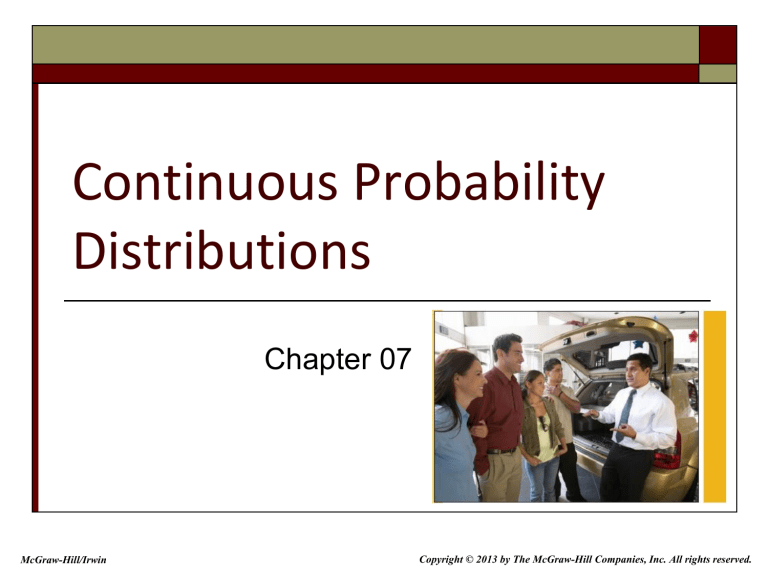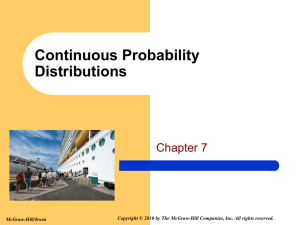
Continuous Probability
Distributions
Chapter 07
McGraw-Hill/Irwin
Copyright © 2013 by The McGraw-Hill Companies, Inc. All rights reserved.
LEARNING OBJECTIVES
LO 7-1 List the characteristics of the uniform distribution.
LO 7-2 Compute probabilities by using the uniform distribution.
LO 7-3 List the characteristics of the normal probability
distribution.
LO 7-4 Convert a normal distribution to the standard normal
distribution.
LO 7-5 Find the probability that an observation on a normally
distributed random variable is between two values.
LO 7-6 Find probabilities using the Empirical Rule.
7-2
LO 7-1 List the characteristics of
the uniform distribution.
The Uniform Distribution
The uniform probability distribution is perhaps
the simplest distribution for a continuous
random variable.
This distribution is rectangular in shape and is
defined by minimum and maximum
values.
7-3
LO 7-2 Compute probabilities
using the uniform distribution.
The Uniform Distribution – Example
EXAMPLE
Southwest Arizona State University provides
bus service to students while they are
on campus. A bus arrives at the North
Main Street and College Drive stop
every 30 minutes between 6 A.M.
and 11 P.M. during weekdays.
Students arrive at the bus stop at
random times. The time that a
student waits is uniformly distributed
from 0 to 30 minutes.
1.
Draw a graph of this distribution.
2.
Show that the area of this uniform
distribution is 1.00.
3.
How long will a student “typically”
have to wait for a bus? In other
words what is the mean waiting
time? What is the standard deviation
of the waiting times?
4.
What is the probability a student will
wait between 10 and 20 minutes?
0.3333
(30 0)
(10)
1
P(25 Wait Time 30) (height)(b ase)
7-4
LO 7-3 List the characteristics of the
normal probability distribution.
Normal Probability Distribution
1.
2.
3.
4.
5.
6.
It is bell-shaped and has a single peak at the
center of the distribution.
It is symmetrical about the mean.
It is asymptotic: The curve gets closer and
closer to the X-axis but never actually
touches it.
The location of a normal distribution is
determined by the mean, , the dispersion
or spread of the distribution is determined
by the standard deviation, σ.
The arithmetic mean, median, and mode
are equal.
The total area under the curve is 1.00; half
the area under the normal curve is to the
right of this center point and the other half
to the left of it.
7-5
LO 7-3
Normal Probability Distribution
Family of Distributions
Different Means and Standard Deviations
Equal Means and Different
Standard Deviations
Different Means and Equal Standard Deviations
7-6
LO 7-4 Convert a normal distribution to
the standard normal distribution
The Standard Normal Probability Distribution
The standard normal
distribution is a normal
distribution with a mean of 0
and a standard deviation of 1.
It is also called the z
distribution.
A z-value is the signed distance
between a selected value,
designated X, and the
population mean , divided by
the population standard
deviation, σ.
The formula is:
7-7
LO 7-4
The Normal Distribution – Example
The weekly incomes of
shift foremen in the
glass industry follow
the normal probability
distribution with a
mean of $1,000 and a
standard deviation of
$100.
What is the z value for the
income, let’s call it X,
of a foreman who
earns $1,100 per
week? For a foreman
who earns $900 per
week?
7-8
LO 7-4
The Normal Distribution – Example
The weekly incomes of
shift foremen in the
glass industry follow
the normal probability
distribution with a
mean of $1,000 and a
standard deviation of
$100.
What is the z value for the
income, let’s call it X,
of a foreman who
earns $1,100 per
week? For a foreman
who earns $900 per
week?
7-9
LO 7-5 Find the probability that an observation on a normally
distributed random variable is between two values.
Normal Distribution – Finding Probabilities
EXAMPLE
The mean weekly income of a shift
foreman in the glass industry is
normally distributed with a mean
of $1,000 and a standard deviation
of $100.
What is the likelihood of selecting a
foreman whose weekly income is
between $1,000 and $1,100?
7-10
LO 7-5
Normal Distribution – Finding Probabilities (Example 2)
Refer to the information regarding
the weekly income of shift
foremen in the glass industry.
The distribution of weekly
incomes follows the normal
probability distribution with a
mean of $1,000 and a standard
deviation of $100.
What is the probability of selecting a
shift foreman in the glass
industry whose income is:
Between $790 and $1,000?
7-11
LO 7-5
Normal Distribution – Finding Probabilities (Example 2)
Refer to the information regarding
the weekly income of shift
foremen in the glass industry.
The distribution of weekly
incomes follows the normal
probability distribution with a
mean of $1,000 and a standard
deviation of $100.
What is the probability of selecting a
shift foreman in the glass
industry whose income is:
Between $840 and $1,200
7-12
LO 7-5
Using z in Finding X Given Area – Example
Layton Tire and Rubber Company
wishes to set a minimum
mileage guarantee on its new
MX100 tire. Tests reveal the
mean mileage is 67,900 with a
standard deviation of 2,050
miles and that the distribution
of miles follows the normal
probability distribution. Layton
wants to set the minimum
guaranteed mileage so that no
more than 4 percent of the
tires will have to be replaced.
What minimum guaranteed mileage
should Layton announce?
7-13
LO 7-5
Using Z in Finding X Given Area – Example
Layton Tire and Rubber Company
wishes to set a minimum
mileage guarantee on its new
MX100 tire. Tests reveal the
mean mileage is 67,900 with a
standard deviation of 2,050
miles and that the distribution
of miles follows the normal
probability distribution. Layton
wants to set the minimum
guaranteed mileage so that no
more than 4 percent of the tires
will have to be replaced.
What minimum guaranteed mileage
should Layton announce?
Solve X using the formula :
x x 67,900
z
2,050
The value of z is found using the 4% informatio n
The area between 67,900 and x is 0.4600, found by 0.5000 0.0400
Using Appendix B.1, the area closest to 0.4600 is 0.4599, which
gives a z alue of 1.75. Then substituti ng into the equation :
1.75
x - 67,900
, then solving for x
2,050
1.75(2,050) x 67,900
x 67,900 1.75(2,050)
x 64,312
7-14
LO 7-6 Find probabilities
using the Empirical Rule.
The Empirical Rule – Example
As part of its quality assurance
program, the Autolite
Battery Company conducts
tests on battery life. For a
particular D-cell alkaline
battery, the mean life is 19
hours. The useful life of the
battery follows a normal
distribution with a
standard deviation of 1.2
hours.
Answer the following questions.
1.
About 68 percent of the
batteries failed between
what two values?
2.
About 95 percent of the
batteries failed between
what two values?
3.
Virtually all of the batteries
failed between what two
values?
7-15



